while WE slept: USTs bid, flatter on SOLID vol; "...the last two <QRA>announcements prompted major market turns"
Good morning.
Bond market was BID yesterday and remains so, this morning. The Treasury Quarterly ReFUNding Announcement (QRA) clearly having yet another (lasting?) impact.
Here is an updated look at 7yy for some context …
… and as we can see, momentum (stochastics) is bullish supporting a further decline in yields at the moment. This, as yields are in short-term UPTREND (noted so as to offer something for everyone — hey Global Wall does it all the time!)
Recent BID credited to supply vs demand dynamics and so, with QRA on the hearts and minds of us all …
ZH: Yields Tumble, Futures Soar After Treasury Unexpectedly Slashes Borrowing Estimates …
There is somewhat more and context below from Global Wall TO the intertubes weighing in. For NOW, though a couple more links,
Bloomberg: US Treasury Cuts Quarterly Borrowing Estimate to $760 Billion
Department releases borrowing estimate for January to March
Treasury also predicts $202 billion net borrowing next quarter
… The smaller borrowing need was driven by higher projected net fiscal flows, and having more cash on hand at the start of the quarter than expected, the department said in a statement. Treasury officials speaking with reporters declined to offer a breakdown on the improvement in fiscal flows relative to previous expectations…
… and with yesterday’s news leading to a good trade in global markets, it’s worth noting other QRA turning points, as John Authers points out this morning HERE
… Possibly even more important will be the announcement Wednesday, before US markets open, of how the Treasury intends to apportion its borrowing. It decided earlier this year to raise far more from short-term bills than usual; whether that continues, and the size of the auctions Uncle Sam wants the market to swallow, remain hugely important questions. If we look at how stocks and bonds have done (in the customary 60/40 portfolio) over the last 12 months, we can see that the last two quarterly refunding announcements both marked big turning points. The need to raise more funding scared the markets in August, and the measures to cushion the blow announced in November were critical to the end-of-year rally that followed:
After the Treasury and the Fed, nobody can slope off for a long weekend. The usual raft of first-day-of-the-month economic numbers from around the world is due on Thursday, followed by Payrolls Friday. Enjoy…
#GotBONDS
… here is a snapshot OF USTs as of 705a:
… HERE is what this shop says be behind the price action overnight…
… WHILE YOU SLEPT
Treasuries are modestly higher and the curve is a touch flatter after Treasury surprised with lower financing estimates yesterday (see discussion below) while Germany and France led Europe into economic stagnation during Q4. DXY is lower (-0.15%) while front WTI futures are little changed. Asian stocks were generally dragged lower by Chinese exchanges (HS China Enterprises index -2.5%), EU and UK share markets are modestly higher (SX5E +0.5%) while ES futures are showing -0.15% here at 6:50am. Our overnight US rates flows saw fast$ selling in intermediates and 2-way action in futures blocks. In London's AM hours, the desk saw mostly 2-way action with still decent demand for 5's-7's evident alongside some light demand for paper on ASW. Overnight Treasury volume was very solid-looking on our sheets (~135% of ave) but the Asian and London desks each reported below-average turnovers. So we need to check our sheets today...… this morning 5yr Treasuries appear to be threatening a new, daily momentum bull signal as you can see in the lower panel of our next attachment. Simply, with 2's caught in the Fed's headlights, 30yr bonds may be leading the rest of the curve out of their bearish corrective phases in place since late last year.
NOTED … and for some MORE of the news you can use » The Morning Hark - 30 Jan 2024 and IGMs Press Picks (who CONTINUES to be sportin’ that new, fresh look) in effort to to help weed thru the noise (some of which can be found over here at Finviz).
Moving from some of the news to some of THE VIEWS you might be able to use… here’s SOME of what Global Wall St is sayin’ …
BARCAP: U.S. Equity Strategy: Election 2024: Taking Stock
US equity returns tend to be muted in an election year; post-Election Day returns vary significantly based on which candidate wins; cyclicals outperformed defensives in both 2016 and 2020; we introduce baskets of stocks with high reactivity to either candidate winning in November.
DB: Early Morning Reid
…In terms of markets, we were in a holding pattern ahead of the big events to come this week until an adrenaline shot came through in the last hour of US trading last night as the US Treasury announced lower-than-expected borrowing estimates for Q1 and Q2 2024. 10yr Treasuries saw their strongest day of the year so far (- 6.3bps) and are another -2.3bps lower overnight at 4.05%. Meanwhile, the S&P 500 posted another solid gain (+0.76%) and another all-time high. Earlier in the day, there was a significant sovereign bond rally in Europe as investors priced in a growing likelihood the ECB would be cutting rates shortly.
Starting with the borrowing announcement, the US Treasury lowered its quarterly borrowing estimate for Jan-Mar from $816bn to $760bn, a larger decline than expected by the market and our US rates strategists. It also announced a modest $202bn borrowing estimate for the Apr-Jun period. These estimates suggest an improvement in the Treasury’s expectation of the budget deficit path. The market will next be watching the details of the Treasury’s coupon auction sizes in tomorrow's refunding statement. Recall that the last quarterly refunding announcement on 1 November marked the start of the dramatic bond rally into year-end…
DB: Trades for the February QRA (2 ideas — short 30yr TIPS and get long short-coups w/maturities ‘round cash outflow dates…)
Monday’s quarterly Treasury borrowing estimates surprised with below-expectation financing needs for the current and next quarters, particularly for Q2. The Treasury’s new estimate suggests a balanced budget for the April-June period, a feat it had not consistently achieved since before Covid. Whether the announced surprise signifies a sustained fiscal improvement is unclear to us at this point. The immediate market reaction post announcement was a rally in both duration and spreads.
While Monday’s surprise opens up the possibility that the Treasury might pare back on its coupon auction size increases even further at Wednesday's quarterly refunding announcement, we think it would ultimately choose to demonstrate its commitment to regular and predictable by maintaining the same pace of increases to nominal coupons as last quarter, and allow the T-bill's share of marketable debt to fall back below the recommended 20% sooner.
While we believe the street also expects the same outcome for nominal coupons, there is less of a consensus view for TIPS, which has uncertainty over which of the three benchmark maturities the Treasury will increase issuance size over the coming quarter. Furthermore, we also anticipate the Treasury to begin implementing buybacks, which could have meaningful price impact on some securities. As intimated in our refunding preview, we see relative-value opportunities in Wednesday’s quarterly refunding announcement. We propose two trades ideas…
DB: Will the Fed get real?
One popular comment from Fed officials on reasons for future easing is the idea that recent lower inflation rates are driving real yields up, and this implied tightening will at some point need reversing. But against this tightening, there is also a stimulatory impact from lower inflation. As inflation slides it i) boosts real disposable income ii) adds to the growth of real money balances; and, iii) supports real wealth if asset inflation is running ahead of goods and services inflation. So which effect should the Fed be emphasizing and what is the impact on markets?
… Now whether the Fed ‘buys into’ the above view of policy channels is another story, but it is an argument why the Fed need not be in a rush to validate the exceptional easing in nominal financial conditions that occurred since Q3. Note also that real financial conditions (FCI) are rarely even considered as a relevant metric for policy over shorter-term horizons.
In practice, even if the Fed does not use the above arguments to rationalize any decision to keep rates steadier for longer, an economy still growing close to trend, provides no impetus for the Fed to validate expectations of an early easing, especially if they still want to err on the side of caution. To that extent, a Fed that is not reactive to lower inflation's impact on real rates, is USD positive…
DB: Monthly Chartbook: When central banks cut rates…what happens next? (It looks at what happens to markets as central banks cut, how inaccurate markets are around turning points in the rate cycle, and some other historical trends. So with markets pricing rate cuts this year across lots of central banks, it’s a topical pack for the coming months)
… Although a big cutting cycle is priced in, remember that the market is usually wrong about the Fed… will they be more accurate this time?
Goldilocks: Why We’re Above Consensus on Growth
The strong 2023Q4 GDP report capped a year in which US GDP rose an impressive 3.1% (Q4/Q4). This Analyst updates our 2024 forecast to reflect recent growth momentum and changes in financial conditions, as well as our latest views on consumer spending, business investment, housing, and the inventory cycle. We are launching our 2024Q1 GDP growth tracking estimate at 2.8%, in part reflecting the upward trajectory of consumer spending within 2023Q4, and we are raising our 2024 Q4/Q4 GDP growth forecast by 0.3pp to 2.4%, well above the consensus forecast of 1.0%…
… Our 2.4% forecast for 2024 Q4/Q4 growth (or 2.9% on a full-year basis) reflects a stronger 2.6% annualized pace in 2024H1 driven by strong consumer spending momentum and the near-term boost to housing from the recent decline in mortgage rates, and then a somewhat softer 2.2% pace in 2024H2 as capex growth related to the IRA and CHIPS Act moderates.
JEFF: Treasury Borrowing Estimates: Financing Needs Cooling in 1H, but Coupon Auction Sizes Still Heading Higher
… For the first time in a while, these borrowing projections are free of distortions from the debt ceiling, or the rebuild of the TGA, or an extended personal income tax deadline for every resident of California due to wildfires. The big step down in borrowing in Q2 reflects the seasonal inflow of personal income tax receipts in April and corporate tax receipts in June. We will stop short of saying that this is a return to "normal" for Q2, a quarter in which Treasury used to routinely make net pay downs in outstanding debt, but this downshift at least approximates normal.
So, what are we to make of these projections? As we have said in the past, there isn't much here to sink your teeth into with the topline borrowing announcements. The borrowing projections have progressively been coming in lower than expected in recent quarters, but we do not feel compelled to change our estimates for the coupon auctions in the upcoming quarter.
To summarize our expectations for Wednesday's announcement, we essentially the same round of increases that we saw in November, summarized below …
JPM: U.S. Fixed Income Markets Weekly (staying long 5s as is MS (noted HERE))
…Treasuries
The calm before the (policy) storm?
We expect the Fed to move to a neutral bias and for Treasury to deliver on last quarter’s guidance. Further, valuations appear fair, and positioning broadly neutral, reducing the risk of large reactions to next week’s events. Accordingly, we continue to hold longs in 5-year Treasuries
The 5s/30s curve no longer appears flat relative to its drivers and might trade more rangebound in coming weeks. However, we continue to hold 5s/30s steepeners as this curve consistently steepens in the period between Fed tightening and easing …
We look for Treasury to announce a final round of increases to nominal auction sizes at next week’s refunding announcement, similar to the increases announced in November. This would be consistent with the guidance offered in the latest policy statement. Further, Treasury remains underfinanced with its current auction schedule and the T-bill share of debt is expected to remain above 20% for the foreseeable future
In the dealer questionnaire, Treasury asked about possible increases in TIPS issuance this year. Overall, we think there is capacity for the market to absorb further gradual, incremental increases in TIPS auction sizes in 2024, and project $1bn increases to each upcoming new-issue TIPS auction and subsequent reopening
NWM: It's Complicated...
Global trade developments
Amidst Red Sea disruptions, upside risks to inflation are difficult to quantifyUBS: Don't overplay the smaller Tsy financing need
Our forecasts for the upcoming auction announcements are below consensus
As discussed in Refunding announcement and spreads, we expect the Treasury to announce a slightly slower pace of auction increases on Wednesday, where the consensus has auctions rising at the same pace as last quarter. While the smaller borrowing needs for Q1 and Q2 makes it modestly more likely that we are right, the change in probability does not seem like enough to justify the late-day move in yields and spreads……Big picture, a slowdown in Feb auction sizes mainly means a shorter pause
The Treasury has said that it expects to stop raising coupon auctions in May. That is in part caused by a slowdown in maturing debt meaning the same sized auctions raises more cash -- from Oct 2021 to Oct 2022, 2yr auctions fell from $60bn to $42bn, so there is a brief lull in maturities before they start growing rapidly in 2025. If the Treasury slows the pace of auction increases this month, it boosts the odds that auctions will need to start growing again in November 2024. If auctions keep rising at the pace seen in the latest quarter, then it is more likely that the lull in auction increases can persist until February 2025.Wells Fargo: Beyond the Sea: Considerations for the Path of Goods Inflation Ahead
Summary
Goods prices have been leading the charge in inflation's slowdown over the past year. Of the nearly six percentage-point decline in the year-over-year rate of U.S. CPI since the summer of 2022, goods have accounted for just under five points of the drop. But the recent jump in ocean and alternative shipping rates threatens to stymie the disinflationary trend in goods that has been a major driver in returning inflation to a less menacing pace.We see higher shipping costs as a headwind to goods disinflation continuing at its recent pace, but the impact is likely to pale in comparison to the perfect storm of 2020-2022 that sent goods inflation to a more than 70-year high. Whereas businesses were facing surges in inputs across the board during that period, including labor and materials, the picture is more mixed today. Moreover, the current jump in shipping costs is tied to a singular supply chain issue, rather than the pandemicperiod's array of negative supply shocks occurring simultaneously with a massive, positive demand shock. With consumer demand less insatiable, inventories better aligned with sales and margins still somewhat elevated, we see the rise in shipping costs, if sustained, as likely to have only a modest upward effect on goods inflation in the coming months.
Looking at the relationship between goods and shipping prices through the pandemic period implies the year-over-year rate of core goods inflation, currently 0.2%, would rise to 2% in July—adding an additional 0.4 points to headline CPI. We see this as an upper-bound estimate, however, if the rise in shipping costs is sustained. Prior to 2020, changes in container rates and broader measures of supply pressures did not bear a statistically significant relationship with core goods inflation, reflecting that transportation accounts for only a slice of total costs and that firms have historically been apt to absorb fluctuations.
The larger consideration for goods inflation ahead, in our view, is that supply chain snarls broadly appear to have unwound over the past year. With supply chain pressures back within “normal” range, a more neutral impulse, rather than a downward impulse, from goods inflation appears in store. We believe there is still some scope for goods disinflation to run this year, but that it will likely proceed more slowly and increasingly reflect stumbling demand given more neutral supply pressures.
Wells Fargo: Up, Down and All Around: A 2023 Review of Animal Spirits
Summary
The Animal Spirits Index (ASI) had a strong close to 2023, shooting up by 0.51 points in December. In all, the ASI was somewhat volatile throughout 2023, largely reflecting the surprising turn that the year took.
While oscillating consumer confidence and economic policy uncertainty weighed heavily on the ASI, financial markets showed remarkable strength and boosted the index throughout the year.
We suspect 2024 will bring continued volatility in the ASI. While we expect the FOMC to begin their cutting cycle this year, which will likely boost the index, a pull back in consumption may accelerate the labor market's moderation, which could weigh heavily on the ASI via lower consumer confidence.
Yardeni: What Will Powell Say?
Fed Chair Jerome Powell might disappoint the markets on Wednesday, when he conducts his press conference to discuss the decision of the latest FOMC meeting. He will say that economic growth has been better than expected and that inflation seems to be falling towards the Fed's 2.0% target faster than expected as well. He knows that the markets are expecting five 25bps cuts in the federal funds rate over the next 12 months. That's according to today's 12-month federal funds rate futures at 4.07% (chart).
He is likely to push back against this notion by observing that financial conditions have eased significantly since late last year…
… And from Global Wall Street inbox TO the WWW,
Apollo: Work from Home Is Here to Stay (not any surprise to a guy who was working remote since … 1998. might be a surprise to some in CRE though?)
The data for office use across the country shows that hybrid work is here to stay, see chart below.
The numbers show the average for a week where Wednesdays can be as high as 60%, and Mondays and Fridays as low as 30%.
The data is weekly and comes from 300,000 workers in 10 different cities, and in New York, the data covers 200 buildings and 70,000 workers.
The latest data shows that the lowest office occupancy rate is for Philadelphia at 37%, and the highest is Austin at 58%.
For more discussion of this topic, see also here.
Bloomberg (via ZH): Treasury-Refunding Has More Market-Moving Potential Than Fed
Wednesday sees the Federal Reserve meeting and the Treasury’s quarterly refunding announcement (QRA). It’s the latter, however, that has the most potential to upset markets through possible disruptions to liquidity and funding.
The overlapping of fiscal and monetary policy will be center stage this week as the Treasury today announces its total borrowing estimates, and on Wednesday how it expects to fund this deficit over the next three months. The Yellen pivot, at the beginning of 2023, allowed the government to fund its large borrowing needs without cratering the market. Skewing issuance towards bills let money market funds (MMFs) lend to the government using trillions of dollars of idle liquidity parked at the Fed’s reverse repo facility (RRP).
But bills are now well over 20% of government debt, a level the Treasury has generally preferred to keep the ratio under. The Treasury may therefore continue to increase auction sizes of notes and bonds, as has gradually started to happen. It was larger-than-expected bond auction sizes at the October QRA that was the initial impetus for the bond sell-off into the end of last year.
Expectations are for bond and note auction-sizes to climb again. It is hard to know exactly what is priced in, but there is a risk of a repeat of October if the increase in auction sizes is large.
Not only could that trigger another bond sell-off, but it could also jeopardize hitherto market-friendly liquidity conditions. MMFs cannot directly buy longer-term debt. Moreover, banks have been reducing their UST holdings, and the Fed is not a buyer while QT is ongoing, thus it will fall mainly on the private non-bank sector to buy the bonds using bank deposits, which will eat up reserves and thus worsen liquidity.
But even if the Treasury keeps bill issuance high (and the yields bills offer stay above the RRP’s rate), that could soon lead to funding issues, also problematic for markets if they move in an uncontrolled fashion.
The domestic RRP has fallen sharply from its peak, and now sits at $570 billion. The closer it gets to zero, the closer we are likely approaching the point where reserves can go from abundant to scarce in a flicker. The chart below shows that historically trading in fed funds (i.e. reserves) has dropped notably when the domestic repo has gone below ~$500 billion.
That’s potentially a sign banks are hoarding reserves, and likely the precursor to funding issues, one of the inputs to my Funding Stress Trigger.
So whatever the Treasury decides to do this week, the structure of the monetary system is such that the days where it could innocuously announce its funding intentions, without fear of upsetting markets, are gone for now.
Bloomberg: Dr. Strangelove, or How I Learned to Love Markets (Authers OpED)
… Monday’s key development came at 3 p.m., when the Treasury made its quarterly refunding announcement and the market dodged another bullet. With federal debt at historically high levels, the minutiae of how much the government borrows and on what terms grow far more important. Senyek had suggested that the greatest risk of a “definitive downside catalyst” could have been an announcement of increased borrowing. Instead, borrowing for this quarter will be lower than previously advised, and then much lower in the second quarter. At least for one day’s trading, that proved to be a definitive up-side catalyst:
Possibly even more important will be the announcement Wednesday, before US markets open, of how the Treasury intends to apportion its borrowing. It decided earlier this year to raise far more from short-term bills than usual; whether that continues, and the size of the auctions Uncle Sam wants the market to swallow, remain hugely important questions. If we look at how stocks and bonds have done (in the customary 60/40 portfolio) over the last 12 months, we can see that the last two quarterly refunding announcements both marked big turning points. The need to raise more funding scared the markets in August, and the measures to cushion the blow announced in November were critical to the end-of-year rally that followed:
After the Treasury and the Fed, nobody can slope off for a long weekend. The usual raft of first-day-of-the-month economic numbers from around the world is due on Thursday, followed by Payrolls Friday. Enjoy.
FirstTrust: A Stock Market Conundrum
The economy is still growing. Real GDP rose at a solid 3.3% annual rate in the fourth quarter, and consumer spending was strong in December meaning the first quarter is off to a good start. New home sales came in above expectations and initial jobless claims remain low, although orders for durable goods came in low due to weak demand for aircraft.
All eyes are now on Friday’s jobs report, which we expect to show a gain of about 170,000 while the unemployment rate holds steady. But the strength in employment seems fragile. If we exclude job gains in government, health & education (which are largely funded by government), and leisure & hospitality (still recovering from lockdowns), job growth looks exceptionally weak. In the last seven months of 2023, payrolls excluding those categories rose only 3,000 per month, the kind of weakness we might expect before a recession. In other words, much of recent growth is fueled by government deficits…
…What would get the Fed to cut rates by 125-150 bps? Either a sharp drop in inflation or a decline in economic growth. While lower inflation is good, can a sharp drop happen without a weak economy? Either way, we don’t think the stock market would like that outcome because they would likely signal lower corporate profits…
…What would it take to suggest that recent stock prices are appropriate? A 10-year yield of 3.2% would do it. So would a 30% increase in profits. But a 3.2% yield would probably be accompanied by lower profits and a 30% surge in profits would likely be accompanied by a much higher 10-year yield, so fair value is even further away than it seems.
The only way out of this conundrum is if Artificial Intelligence and other new and rapidly advancing technologies provide a miraculous boost to productivity. This could keep growth strong, or even accelerate it, while bringing inflation down. In other words, profits up and interest rates down.
While this could happen, it would take a miracle. And while expecting miracles worked for San Francisco fans, we still think investors should remain cautious. The monetary and fiscal stimulus that made COVID lockdowns seem like a bump in the economic road are wearing off.
WolfST: Treasury Department Trying Very Hard to Push Down Yields with its Quarterly Refunding Announcements. So We Take a Look
The actual actual increase in marketable Treasury securities is far higher than the “actual” increase announced in the Quarterly Refunding documents.
… The Treasury Department’s Quarterly Refunding announcements of marketable securities added to the pile don’t quite match the actual increase in marketable securities.
The total Treasury securities outstanding ($34.1 trillion currently) come in two portions: marketable securities ($27.0 trillion currently), which all kinds of investors buy and trade; and non-marketable securities ($7.1 trillion currently), which are held by US government pension funds, the Social Security Trust fund, etc. The Treasury department is talking about issuance of marketable securities.
So the Treasury department said today that it added $1.01 trillion (“actual”) in Q3 to marketable securities and $776 billion (“actual”) in Q4, or $1.786 trillion combined. We marked these “actuals” in red on the “Sources and Uses Reconciliation Table” released today (excerpt; total table here):
But over the same two quarters, marketable Treasury securities actually actually increased respectively by $1.35 trillion and $894 billion, or by $2,248 trillion combined.
Increase in Marketable Securities outstanding, billion $Treasury Dept: “actual” increaseActual actual increaseOverQ3 2023$1,010$1,354$344Q4 2023$776$894$118Total$1,786$2,248$462
In three months, we’ll know how much the expected addition of $760 billion IN Q1 actually added to marketable securities in Q1. And in six months, we’ll know how much the expected addition of $202 billion for Q2 will have actually added to marketable securities in Q2. We’ll surely take a look…
ZH: Yields Tumble, Futures Soar After Treasury Unexpectedly Slashes Borrowing Estimates
Yields Tumble, Futures Soar After Treasury Unexpectedly Slashes Borrowing Estimates
After two very "eventful" quarterly refunding announcements by the Treasury, the first of which sent yields soaring to decade highs, when the Treasury forecast higher than expected coupon issuance in July, followed by a mirror image in October, when the Treasury surprised with slightly lower coupon issuance (offset by a surge in Bill issuance)...
... moments ago the Treasury published the first part of this week's closely watched Quarterly Refunding Announcement, when at 3pm ET it released the estimates borrowing estimates (and overall sources and uses of Treasury debt and cash) for calendar Q1 and Q2, both of which came in well below estimates.
As a reminder, in our preview last night we showed that Deutsche Bank - which was indicative of the overall street - was expecting $797BN in Q1 borrowing, followed by $472BN in total Q2 borrowings.
In the end, both numbers ended up being very high, because according to the Treasury, it now expects to borrow "only" $760 billion in debt, which is $55 billion lower than what it expected in October 2023, and is about $30BN below wall street estimates. The difference the Treasury explained is "largely due to projections of higher net fiscal flows and a higher beginning of quarter cash balance." In other words, Treasury expects higher taxes to more than make up the $55BN difference from the previous estimate. Treasury officials speaking with reporters declined to offer a breakdown on the improvement in fiscal flows relative to previous expectations, Bloomberg reported..
Then, looking further out, during the April – June 2024 quarter, the Treasury now expects to borrow only $202 billion in debt. While there was no previous Treasury forecast for this period, Wall Street expected a number somewhere in the $500BN vicinity, so clearly this is far lower than preciously expected. To be sure, dealers have warned that there’s much more uncertainty regarding financing estimates for the second quarter. Along with the Fed’s plans for its quantitative tightening program, another unknown is prospects for Congress enacting a $78 billion tax bill — which would dramatically worsen the deficit. Of course, the Treasury forecasts do not account for that.
“The outlook for the Wyden-Smith tax bill is a major swing factor,” and at present we “flipped a coin and decided to assume that the legislation would not be approved,” Lou Crandall at Wrightson ICAP LLC said in a note before the Treasury’s Monday release. He penciled in $410 billion for net borrowing for the three months through June, ending with a $750 billion cash balance.
In other words, the Q1 numbers but especially the Q2 are... well... completely made up for lack of a better word.
Finally, turning to the just past calendar Q4, the Treasury borrowed $776 billion in debt - precisely on top of what it had expected as of 3 months ago - and ended the quarter with a cash balance of $769 billion, some $19 billion higher than the benchmark estimate of $750 billion as of Q3: "the ending cash balance was $19 billion higher due primarily to other sources of financing including lower than projected discount on marketable borrowing."
Here is the data in table format:
The reason why the data was shocking to Wall Street is because, as we previewed yesterday, most of the Wall Street sellside had anticipated a slight boost to the borrowing estimate, in part due to the fiscal deficit widening in recent months and in part because the TBAC itself said three months ago to expect an increase in issuance this quarter. Indeed, Deutsche Bank was positively tame: consider that Jay Barry, co-head of US rates strategy at JPMorgan, predicted an $855 billion net borrowing figure for this quarter, assuming a $750 billion cash balance at the end of the period.
While the Treasury is still facing rising costs to refinance its existing debt in wake of the Federal Reserve lifting its policy rate from near zero in 2022 to over 5%, yields tumbled over the past quarter as traders bet on a pivot to easing in 2024. A potential tapering, or end, of the Fed’s bond-portfolio runoff has also boosted sentiment — a shift that would also ease borrowing pressure on the Treasury.
The backdrop has most dealers expecting the Treasury on Wednesday to announce a final round of increases to note and bond sales, at its so-called quarterly refunding.
Even more importantly, what the Treasury's latest forecast means is that the relentless deficit boost - which was behind the economic surge (due to reduced tax payments and much higher government stimulus spending) known as Bidenomics - is coming to an end.
We disagree, and are confident that just like all the other lies in this administration, the Treasury forecast is just Yellen working on behalf of the Administration to prevent a yield spike, because if the Treasury had admitted what is really coming yields would be soaring right now. Instead, in three months time, when we get the next quarterly "actuals", we will find that the Treasury had been off by a few hundred billion in its estimates, and how can that not be when one take a quick look at what is coming.
The numbers also mean that the Reverse Repo facility will be fully drained by Q2, and we expect that on Wednesday we will learn that the bulk of the reduction in Q1 and Q2 estimates will be due to sharply lower Bill issuance for one simple reason: there is just no more Reverse Repo cash to buy it all.
In any case, in kneejerk reaction to the Treasury new, the market was more than happy to send yields plunging...
... and stocks surging to new all time highs because we are clearly now in a period when Biden, having given up on the "But i lowered your inflation" narrative is instead gunning for the lowest common denominator: pushing stock to a new all time high by November in hopes that at least will buy him the needed votes to defeat trump.
AND … THAT is all for now. Off to the day job…



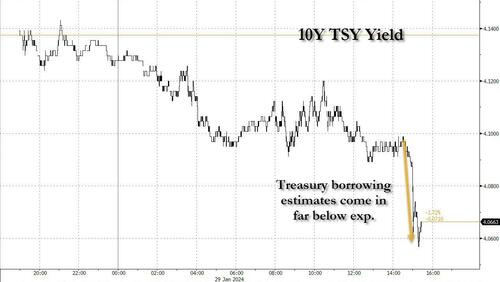
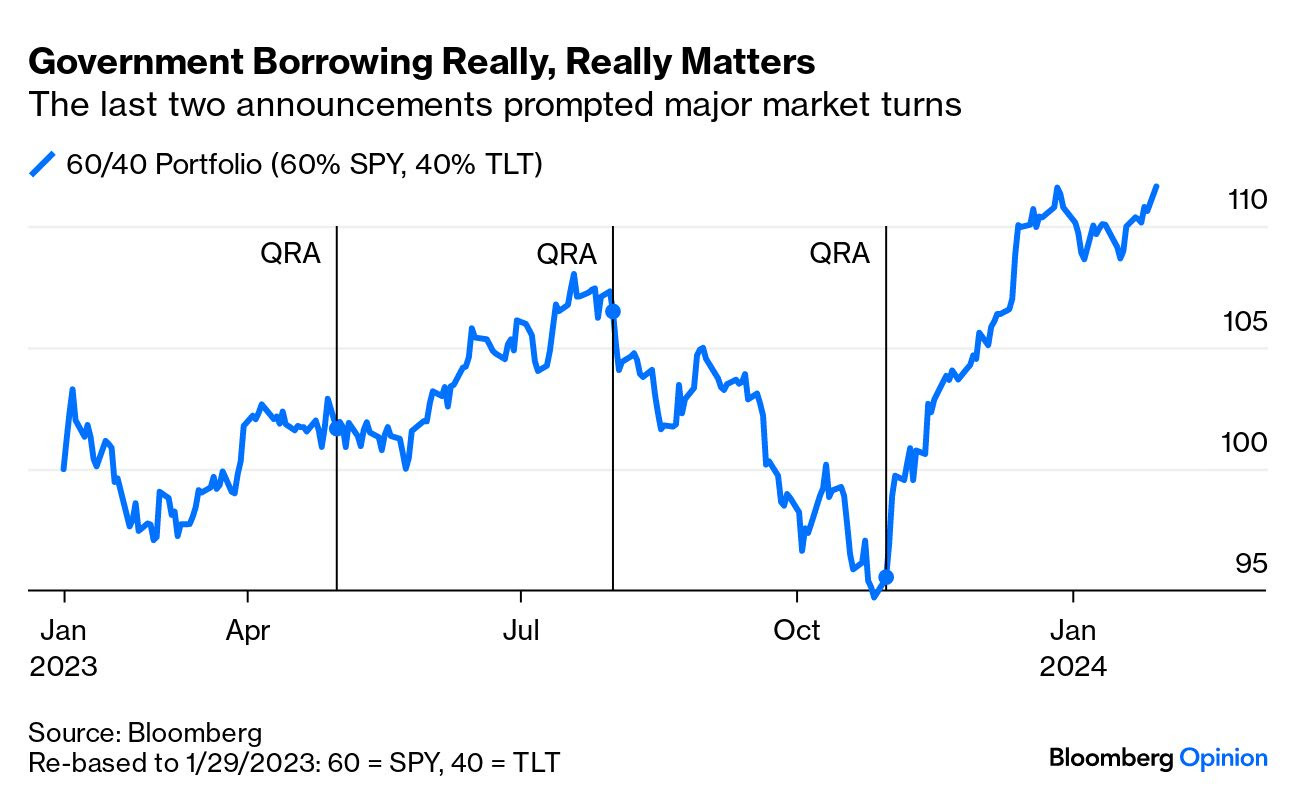
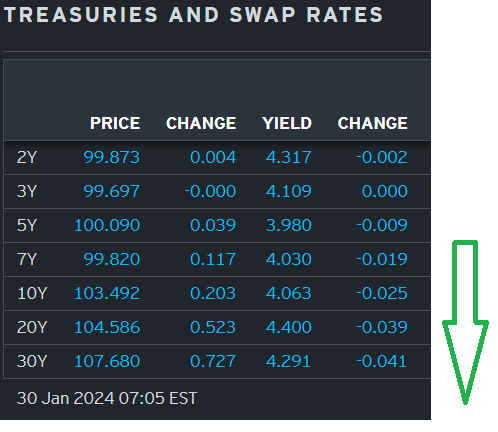








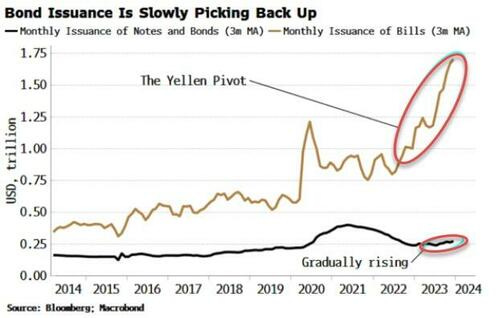
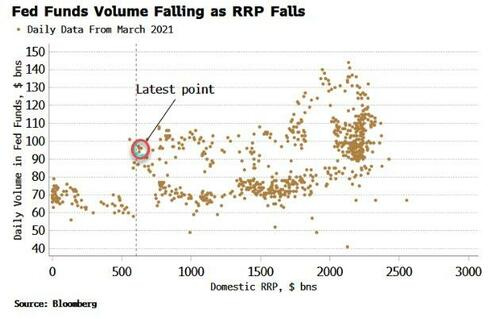
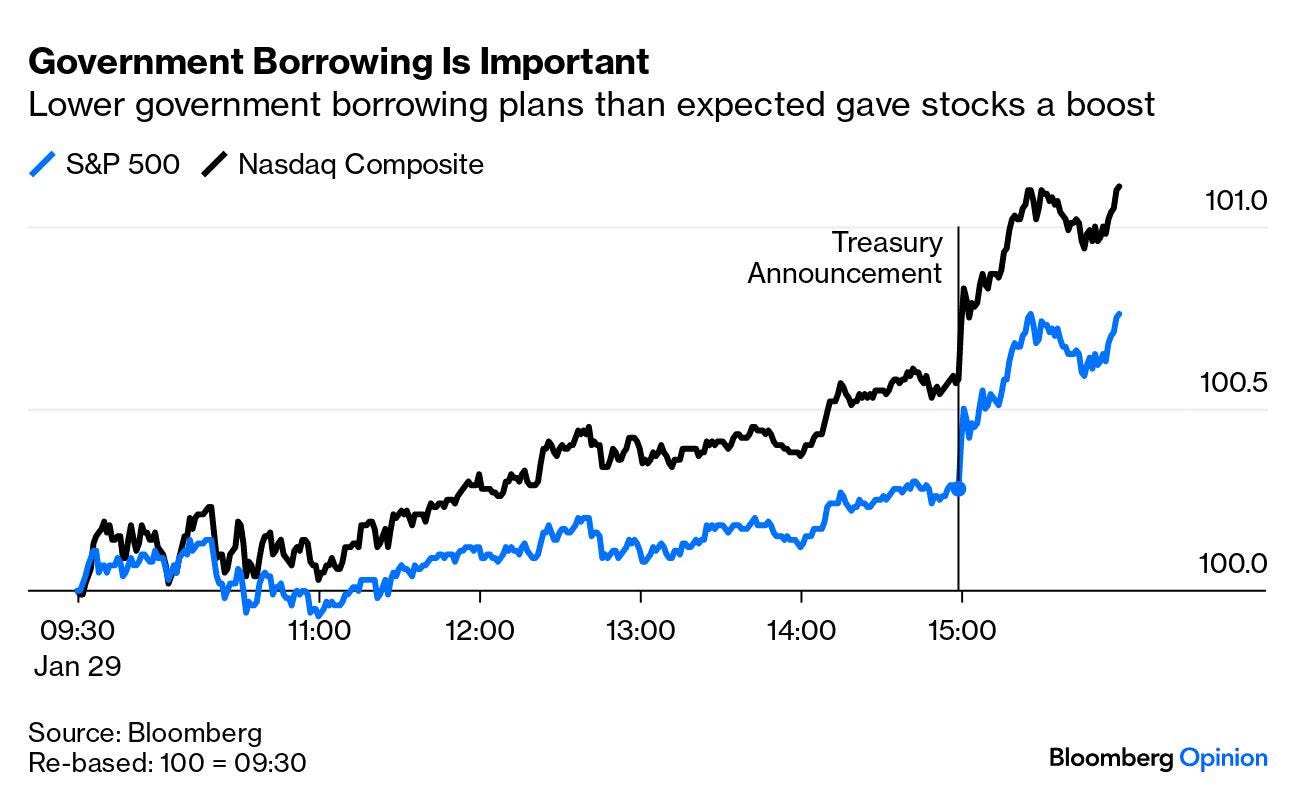
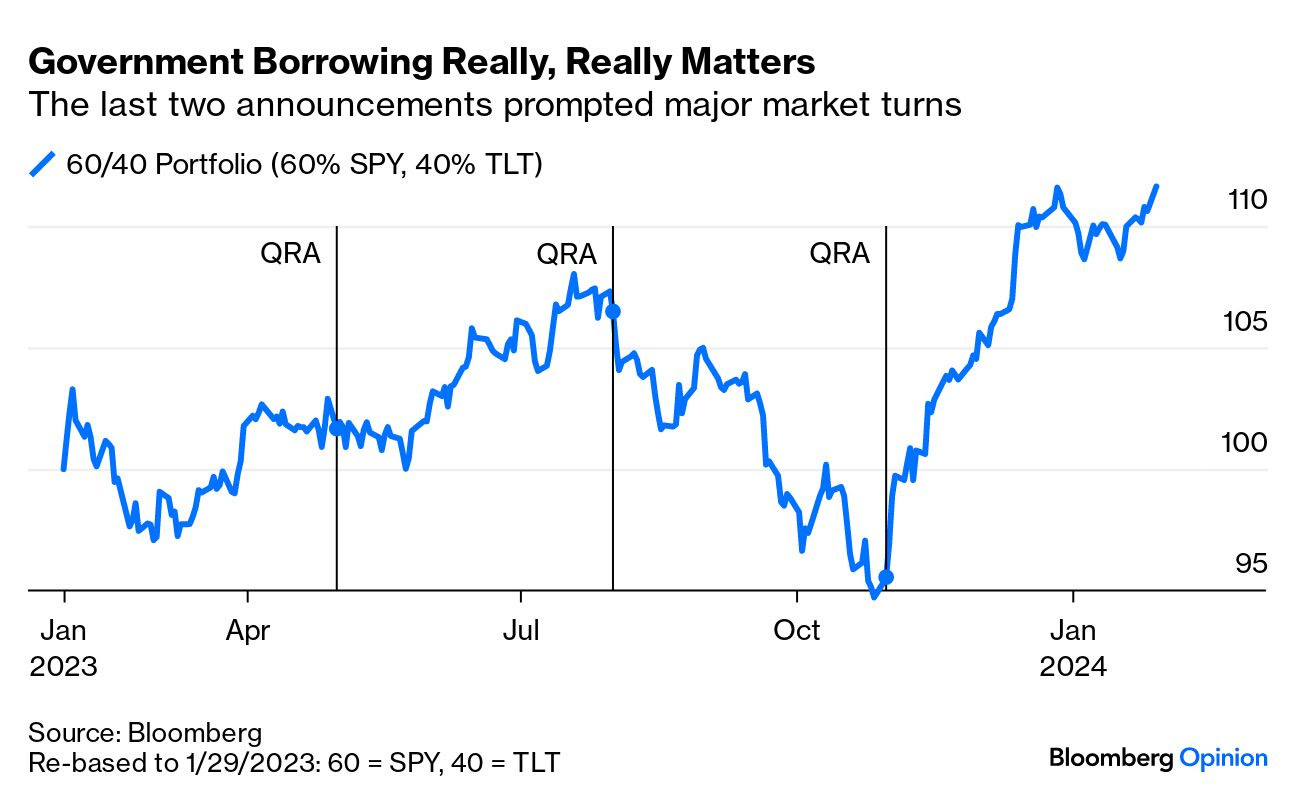

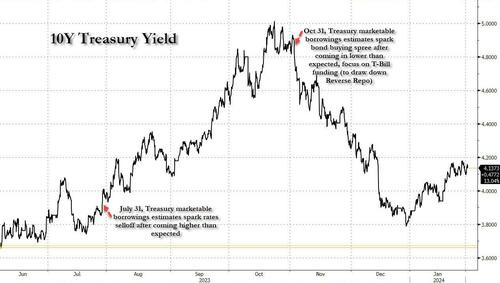
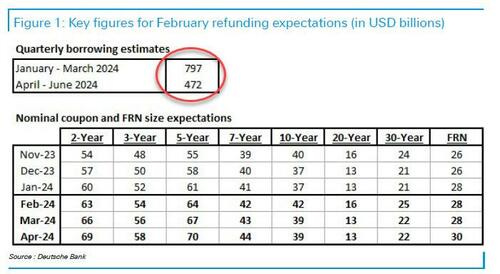
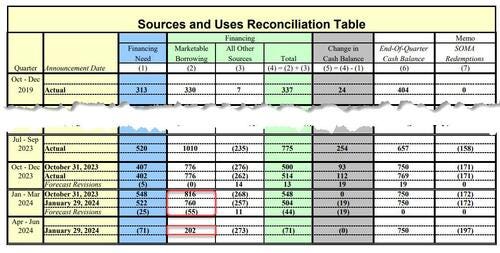
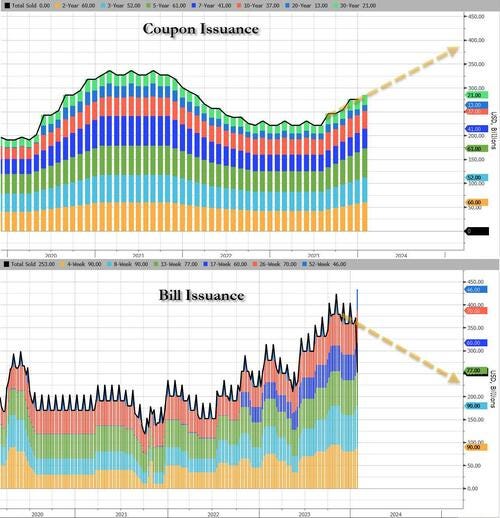
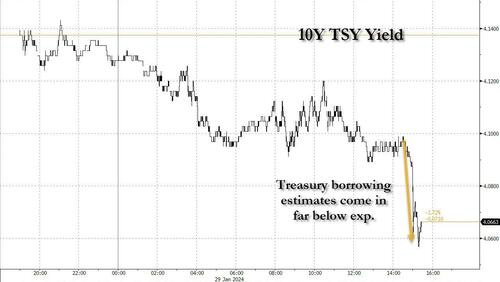
Very early in my Alt-Fin journey I discovered the MacAlvaney wkly podcast. There's a quote, from spring 2019, that I didn't then understand, but was burned into memory: "consider these markets (US & EU) as Soviet in nature". As 'conservative' Trump, supposedly Mr. Free Market himself was the Pres, I was extremely confused. As RepoCrisis, Covid, 2 Emergency Fed meetings in a matter of wks, QE-Infinity, and CARES Act manifested, 'Soviet in nature' made more sense. I read that Wolf St before reading your post-I save the best for last! What once confused me, now only induces eye rolls and vomitous.